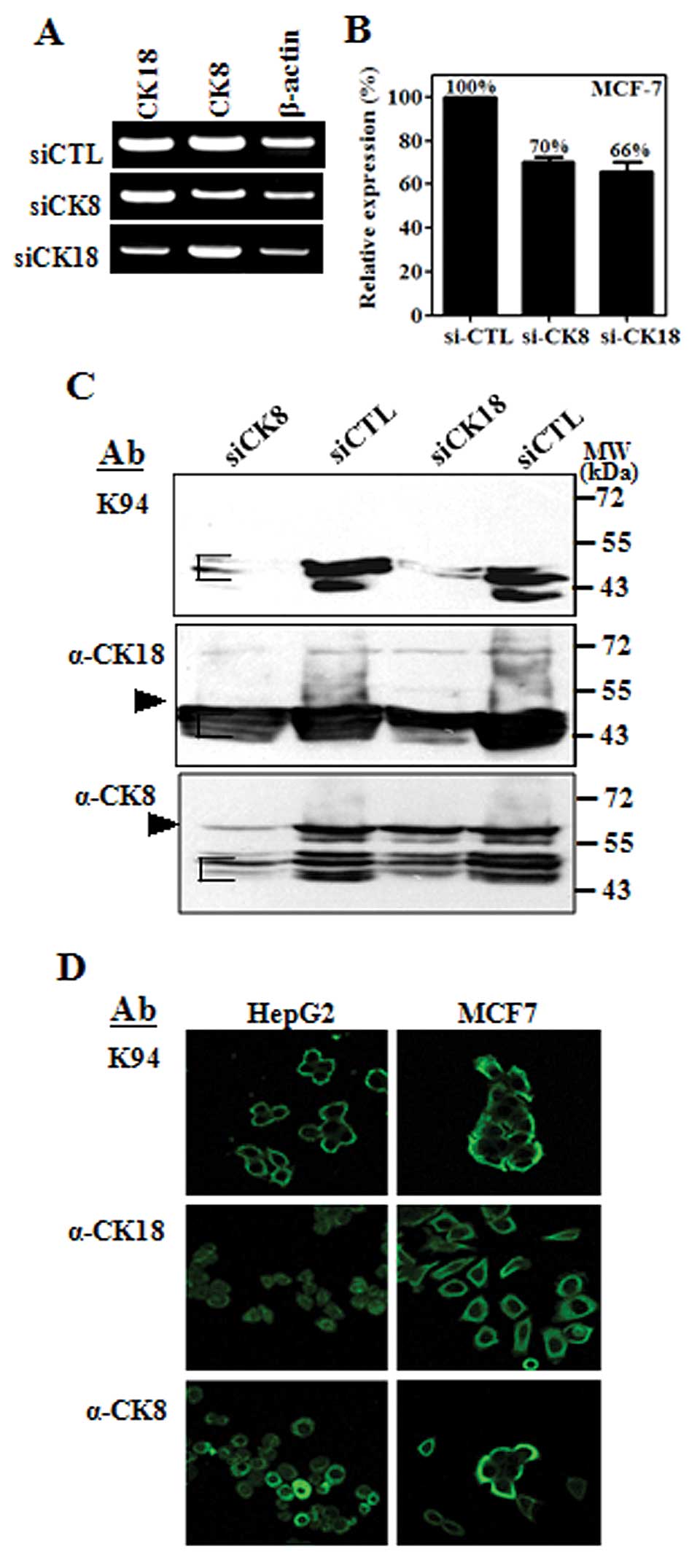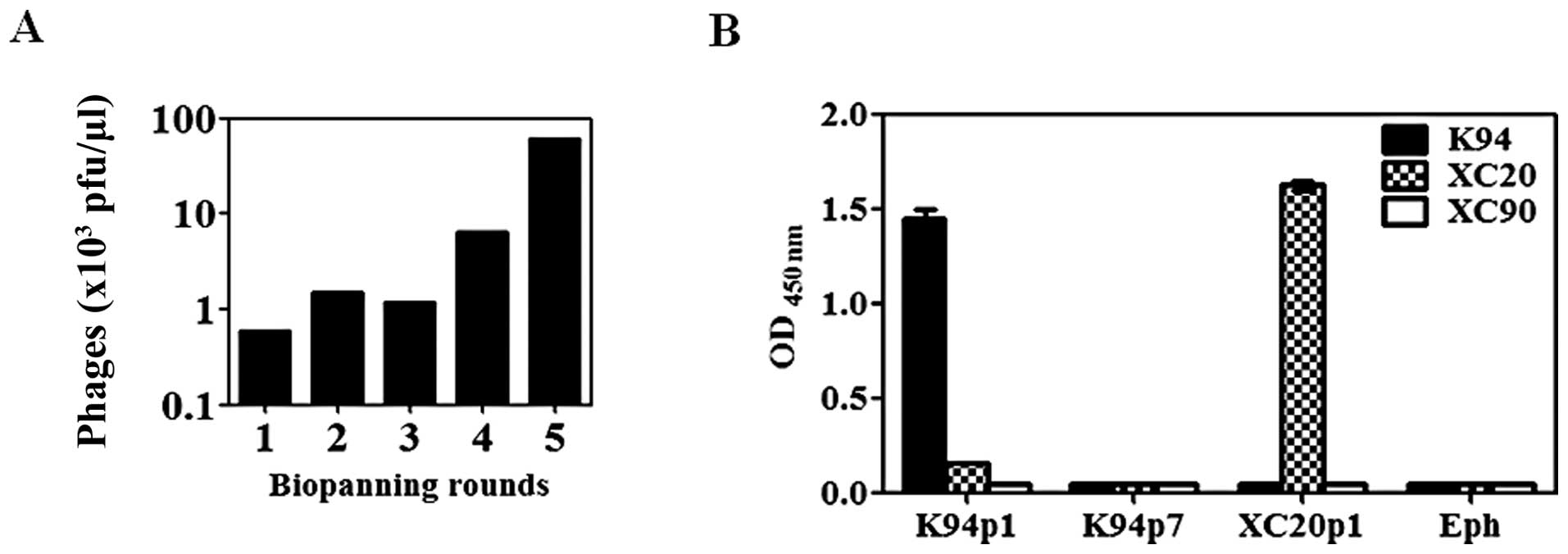|
1.
|
Piura E and Piura B: Autoantibodies to
tumor-associated antigens in breast carcinoma. J Oncol.
2010:2649262010. View Article : Google Scholar : PubMed/NCBI
|
|
2.
|
Tan EM and Zhang J: Autoantibodies to
tumor-associated antigens: reporters from the immune system.
Immunol Rev. 222:328–340. 2008. View Article : Google Scholar : PubMed/NCBI
|
|
3.
|
Thomas PJ, Kaur JS, Aitcheson CT, Robinson
WA and Tan EM: Antinuclear, antinucleolar, and anticytoplasmic
antibodies in patients with malignant melanoma. Cancer Res.
43:1372–1380. 1983.PubMed/NCBI
|
|
4.
|
Tan HT, Low J, Lim SG and Chung MC: Serum
autoantibodies as biomarkers for early cancer detection. FEBS J.
276:6880–6904. 2009. View Article : Google Scholar : PubMed/NCBI
|
|
5.
|
Krackhardt AM, Witzens M, Harig S, et al:
Identification of tumor-associated antigens in chronic lymphocytic
leukemia by SEREX. Blood. 100:2123–2131. 2002. View Article : Google Scholar : PubMed/NCBI
|
|
6.
|
Tureci O, Usener D, Schneider S and Sahin
U: Identification of tumor-associated autoantigens with SEREX.
Methods Mol Med. 109:137–154. 2005.PubMed/NCBI
|
|
7.
|
Nam MJ, Madoz-Gurpide J, Wang H, et al:
Molecular profiling of the immune response in colon cancer using
protein micro-arrays: occurrence of autoantibodies to ubiquitin
C-terminal hydrolase L3. Proteomics. 3:2108–2115. 2003. View Article : Google Scholar : PubMed/NCBI
|
|
8.
|
Ehrlich JR, Tang L, Caiazzo RJ Jr, et al:
The ‘reverse capture’ autoantibody microarray : an innovative
approach to profiling the autoantibody response to tissue-derived
native antigens. Methods Mol Biol. 441:175–192. 2008.
|
|
9.
|
Nesterova M, Johnson N, Cheadle C and
Cho-Chung YS: Autoantibody biomarker opens a new gateway for cancer
diagnosis. Biochim Biophys Acta. 1762:398–403. 2006. View Article : Google Scholar : PubMed/NCBI
|
|
10.
|
Heo CK, Woo MK, Yu DY, et al:
Identification of autoantibody against fatty acid synthase in
hepatocellular carcinoma mouse model and its application to
diagnosis of HCC. Int J Oncol. 36:1453–1459. 2010.PubMed/NCBI
|
|
11.
|
Wang AG, Moon HB, Lee MR, et al:
Gender-dependent hepatic alterations in H-ras12V transgenic mice. J
Hepatol. 43:836–844. 2005. View Article : Google Scholar : PubMed/NCBI
|
|
12.
|
Lee JW, Lee SY, Song H and Yoo JS: The
proteome of Mannheimia succiniciproducens, a capnophilic
rumen bacterium. Proteomics. 6:3550–3566. 2006.PubMed/NCBI
|
|
13.
|
Ditzel HJ, Strik MC, Larsen MK, et al:
Cancer-associated cleavage of cytokeratin 8/18 heterotypic
complexes exposes a neoepitope in human adenocarcinomas. J Biol
Chem. 277:21712–21722. 2002. View Article : Google Scholar : PubMed/NCBI
|
|
14.
|
Fuchs E and Weber K: Intermediate
filaments: structure, dynamics, function, and disease. Annu Rev
Biochem. 63:345–382. 1994. View Article : Google Scholar : PubMed/NCBI
|
|
15.
|
Abe M and Oshima RG: A single human
keratin 18 gene is expressed in diverse epithelial cells of
transgenic mice. J Cell Biol. 111:1197–1206. 1990. View Article : Google Scholar : PubMed/NCBI
|
|
16.
|
Wang X, Yu J, Sreekumar A, et al:
Autoantibody signatures in prostate cancer. N Engl J Med.
353:1224–1235. 2005. View Article : Google Scholar : PubMed/NCBI
|
|
17.
|
Gonzalez-Gronow M, Cuchacovich M, Llanos
C, Urzua C, Gawdi G and Pizzo SV: Prostate cancer cell
proliferation in vitro is modulated by antibodies against
glucose-regulated protein 78 isolated from patient serum. Cancer
Res. 66:11424–11431. 2006. View Article : Google Scholar : PubMed/NCBI
|
|
18.
|
Woo MK, Heo CK, Hwang HM, Ko JH, Yoo HS
and Cho EW: Optimization of phage-immobilized ELISA for
autoantibody profiling in human sera. Biotechnol Lett. 33:655–661.
2011. View Article : Google Scholar : PubMed/NCBI
|
|
19.
|
Keshaviah A, Dellapasqua S, Rotmensz N, et
al: CA15.3 and alkaline phosphatase as predictors for breast cancer
recurrence: a combined analysis of seven International Breast
Cancer Study Group trials. Ann Oncol. 18:701–708. 2007. View Article : Google Scholar
|
|
20.
|
Jesneck JL, Mukherjee S, Yurkovetsky Z, et
al: Do serum biomarkers really measure breast cancer? BMC Cancer.
9:1642009. View Article : Google Scholar : PubMed/NCBI
|
|
21.
|
Ferrini R, Mannino E, Ramsdell E and Hill
L: Screening mammography for breast cancer: American College of
Preventive Medicine practice policy statement. Am J Prev Med.
12:340–341. 1996.PubMed/NCBI
|
|
22.
|
Rosenberg AL, Schwartz GF, Feig SA and
Patchefsky AS: Clinically occult breast lesions: localization and
significance. Radiology. 162:167–170. 1987. View Article : Google Scholar : PubMed/NCBI
|
|
23.
|
Blixt O, Bueti D, Burford B, et al:
Autoantibodies to aberrantly glycosylated MUC1 in early stage
breast cancer are associated with a better prognosis. Breast Cancer
Res. 13:R252011. View
Article : Google Scholar : PubMed/NCBI
|
|
24.
|
Anderson KS, Sibani S, Wallstrom G, et al:
Protein microarray signature of autoantibody biomarkers for the
early detection of breast cancer. J Proteome Res. 10:85–96. 2011.
View Article : Google Scholar : PubMed/NCBI
|
|
25.
|
Zhong L, Ge K, Zu JC, et al:
Autoantibodies as potential biomarkers for breast cancer. Breast
Cancer Res. 10:R402008. View
Article : Google Scholar : PubMed/NCBI
|
|
26.
|
Anderson KS, Ramachandran N, Wong J, et
al: Application of protein microarrays for multiplexed detection of
antibodies to tumor antigens in breast cancer. J Proteome Res.
7:1490–1499. 2008. View Article : Google Scholar : PubMed/NCBI
|
|
27.
|
Wandall HH, Blixt O, Tarp MA, et al:
Cancer biomarkers defined by autoantibody signatures to aberrant
O-glycopeptide epitopes. Cancer Res. 70:1306–1313. 2010. View Article : Google Scholar : PubMed/NCBI
|
|
28.
|
Oshima RG, Baribault H and Caulin C:
Oncogenic regulation and function of keratins 8 and 18. Cancer
Metastasis Rev. 15:445–471. 1996. View Article : Google Scholar : PubMed/NCBI
|
|
29.
|
Schaafsma HE, Van Der Velden LA, Manni JJ,
et al: Increased expression of cytokeratins 8, 18 and vimentin in
the invasion front of mucosal squamous cell carcinoma. J Pathol.
170:77–86. 1993. View Article : Google Scholar : PubMed/NCBI
|
|
30.
|
Hendrix MJ, Seftor EA, Chu YW, et al:
Coexpression of vimentin and keratins by human melanoma tumor
cells: correlation with invasive and metastatic potential. J Natl
Cancer Inst. 84:165–174. 1992. View Article : Google Scholar : PubMed/NCBI
|
|
31.
|
Pankov R, Simcha I, Zoller M, Oshima RG
and Ben-Ze’ev A: Contrasting effects of K8 and K18 on stabilizing
K19 expression, cell motility and tumorigenicity in the BSp73
adenocarcinoma. J Cell Sci. 110:965–974. 1997.PubMed/NCBI
|
|
32.
|
Schutte B, Henfling M and Ramaekers FC:
DEDD association with cytokeratin filaments correlates with
sensitivity to apoptosis. Apoptosis. 11:1561–1572. 2006. View Article : Google Scholar : PubMed/NCBI
|
|
33.
|
Frye BC, Halfter S, Djudjaj S, et al:
Y-box protein-1 is actively secreted through a non-classical
pathway and acts as an extra-cellular mitogen. EMBO Rep.
10:783–789. 2009. View Article : Google Scholar : PubMed/NCBI
|
|
34.
|
Muralidharan-Chari V, Clancy JW, Sedgwick
A and D’Souza-Schorey C: Microvesicles: mediators of extracellular
communication during cancer progression. J Cell Sci. 123:1603–1611.
2010. View Article : Google Scholar : PubMed/NCBI
|
|
35.
|
Camussi G, Deregibus MC, Bruno S,
Cantaluppi V and Biancone L: Exosomes/microvesicles as a mechanism
of cell-to-cell communication. Kidney Int. 78:838–848. 2010.
View Article : Google Scholar : PubMed/NCBI
|
|
36.
|
Desmetz C, Mange A, Maudelonde T and
Solassol J: Autoantibody signatures: progress and perspectives for
early cancer detection. J Cell Mol Med. 15:2013–2024. 2011.
View Article : Google Scholar : PubMed/NCBI
|
|
37.
|
Ditzel H, Rasmussen JW, Erb K, et al:
Tumor detection with 131I-labeled human monoclonal antibody COU-1
in patients with suspected colorectal carcinoma. Cancer Res.
53:5920–5928. 1993.PubMed/NCBI
|















